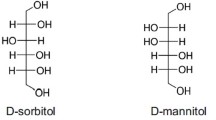Summary
In experiments on conscious dogs Na- and H2O-balances were investigated after massive saline infusions (7 ml/min over a period of 3 hours).
-
1.
Na depleted animals retained 45% of the infused Na during an observation period of 24 hours. The retained amount of Na was often much larger than the deficit, caused by previous withdrawal (peritoneal dialysis). H2O-excretion is almost completed 12 hours after infusion. At this time, PNa is considerably increased, causing hyperosmolarity of the plasma. Plasma volume (PV) previously reduced by Na-depletion, is restored 12 hours after infusion with a transient overshoot during infusion. Over a period of 5 hours water diuresis occurs with a mean U/Posmol of 0.5.
-
2.
Na rich fed animals with consecutive high total body sodium excrete infused Na and H2O within 24 hours completely. After a period of 12 hours PNa and PV have returned to control values. It is believed that in Na rich animals the principles of Na- and H2O-excretion are different from those in Na depleted animals. Although in both groups the H2O-reabsorbing forces on the peritubular level are reduced because of the lowered capillary oncotic pressure after saline infusion, the Na depleted animals retain more Na because of their massive aldosteron activity. H2O-excretion, however, is promoted by inhibition of ADH-secretion following volume reflex activation. Na fed animals loose Na because of their lack of aldosterone. This in turn causes water loss by osmotic diuresis.
Zusammenfassung
An wachen Hunden werden Na und H2O-Bilanzen nach massiven isotonen NaCl-Infusionen aufgenommen. Dabei ergeben sich bedeutende Unterschiede abhängig vom Na-Bestand der Tiere.
-
1.
Na-verarmte Tiere retinieren im Mittel 45% des mit der Infusion zugeführten Na. Die retinierte Na-Menge ist bedeutend größer als es dem Na-Defizit entspricht, das durch Peritonealdialyse und Na-arme Kost erzeugt wurde. Die Ausscheidung des zugeführten Wassers ist nach 12 Std nahezu vollständig, womit angesichts der starken Na-Retention eine beträchtliche Steigerung der Plasma-Na-Konzentration PNa resultiert. Das durch die vorausgehende Salzverarmung reduzierte Plasmavolumen (PV) ist infolge der Infusion stark erhöht und erreicht gegen Ende des Versuches den Standardwert des normal ernährten Tieres. Das U/Posmol sinkt im Mittel auf 0,5 ab, was einer Wasserdiurese entspricht.
-
2.
Na-reich ernährte Tiere mit hohem Na-Bestand scheiden innerhalb eines Tages nach der Infusion das gesamte zugeführte Na und Wasser aus. Dementsprechend bleiben sowohl PNa wie PV in annähernd normalen Grenzen. Die Mechanismen der Na- und H2O-Ausscheidung sind andere wie bei Na-verarmten Tieren. Es wird vermutet, daß infolge der verminderten Aktivität von Aldosteron und peritubulären Kontrollmechanismen eine Natriurese entsteht, die osmotisch Wasser mitreißt.
Access this article
We’re sorry, something doesn't seem to be working properly.
Please try refreshing the page. If that doesn't work, please contact support so we can address the problem.
Similar content being viewed by others
Literatur
Behrenbeck, D. W., u.H. W. Reinhardt: Untersuchungen an wachen Hunden über die Einstellung der Natriumbilanz. II. Postprandiale Elektrolyt- und Wasserbilanz bei unterschiedlicher Kochsalzzufuhr. Pflügers. Arch. ges. Physiol.295, 280 (1967).
Gauer, O. H., J. P. Henry, H. O. Sieker, andW. E. Wendt: Heart and lungs as a receptor region controlling blood volume. Amer. J. Physiol.167, 786 (1951).
Kramer, K., J. W. Boylan, andW. Keck: Regulation of total body sodium in the mammalian organism. Nephron6, 379 (1969).
Ladd, M., andL. G. Raisz: Response of the normal dog to dietary sodium chloride. Amer. J. Physiol.159, 149 (1949).
Levinsky, N. G., andR. C. Lalone: The mechanism of sodium diuresis after saline infusion in the dog. J. clin. Invest.42, 1261 (1963).
Lewy, J. E., andE. E. Windhager: Peritubular control of proximal tubular fluid reabsorption in the rat kidney. Amer. J. Physiol.214, 943 (1968).
Lindheimer, M. D., R. C. Lalone, andN. G. Levinsky: Evidence that an acute increase in glomerular filtration has little effect on sodium excretion in the dog unless extracellular volume is expanded. J. clin. Invest.46, 256 (1967).
Luetscher, J. A., Jr., andB. J. Axelvad: Increased aldosterone output during sodium deprivation in normal men. Proc. Soc. exp. Biol. (N. Y.)87, 650 (1954).
Nizet, A.: Influence of serumalbumin and dextran on sodium and water excretion by the isolated dog kidney. Pflügers Arch. ges. Physiol.301, 7 (1968).
Reinhardt, H. W., u.D. W. Behrenbeck: Untersuchungen an wachen Hunden über die Einstellung der Natriumbilanz. I. Die Bedeutung des Extracellulärraumes für die Einstellung der Natrium-Tagesbilanz. Pflügers Arch. ges. Physiol.295, 266 (1967).
Rovner, D. R., I. W. Conn, R. F. Knopf, E. L. Cohen, andM. T.-Y. Hsueh: Nature of renal escape from the sodium-retaining effect of aldosterone in primerary aldosteronism and in normal subjects. Endocrinology25, 53 (1965).
Vereerstraeten, P., andM. de Myttenaere: Effect of raising the transtubular oncotic gradient on sodium excretion in the dog. Pflügers. Arch.302, 1 (1968).
Wolff, H. P., G. Henne, F. Krück, S. Roscher, P. Vescei, J. J. Brown, G. Düsterdieck, A. F. Lever u.J. I. S. Robertson: Psychosomatische Syndrome mit gastrointestinalem und/oder renalem Kalium- und Natriumverlust, Hyperreninämie und sekundärem Aldosteronismus. Schweiz. med. Wschr.98, 1883 (1968).
Author information
Authors and Affiliations
Rights and permissions
About this article
Cite this article
Keck, W., Brechtelsbauer, H. & Kramer, K. Wasser- und Natrium-Ausscheidung nach isotonen Kochsalz-Infusionen bei wachen Hunden mit verschiedenem Natriumbestand. Pflugers Arch. 311, 119–130 (1969). https://doi.org/10.1007/BF00587034
Received:
Issue Date:
DOI: https://doi.org/10.1007/BF00587034



